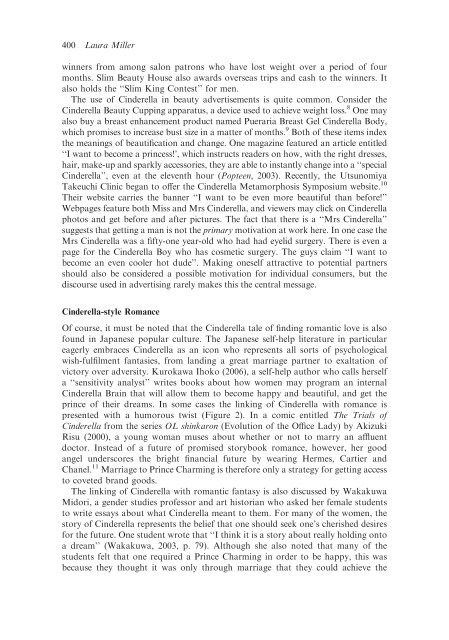Japan's Cinderella Motif: Beauty Industry and Mass Culture ...
Japan's Cinderella Motif: Beauty Industry and Mass Culture ...
Japan's Cinderella Motif: Beauty Industry and Mass Culture ...
Create successful ePaper yourself
Turn your PDF publications into a flip-book with our unique Google optimized e-Paper software.
400 Laura Miller<br />
winners from among salon patrons who have lost weight over a period of four<br />
months. Slim <strong>Beauty</strong> House also awards overseas trips <strong>and</strong> cash to the winners. It<br />
also holds the ‘‘Slim King Contest’’ for men.<br />
The use of <strong>Cinderella</strong> in beauty advertisements is quite common. Consider the<br />
<strong>Cinderella</strong> <strong>Beauty</strong> Cupping apparatus, a device used to achieve weight loss. 8 One may<br />
also buy a breast enhancement product named Pueraria Breast Gel <strong>Cinderella</strong> Body,<br />
which promises to increase bust size in a matter of months. 9 Both of these items index<br />
the meanings of beautification <strong>and</strong> change. One magazine featured an article entitled<br />
‘‘I want to become a princess!’, which instructs readers on how, with the right dresses,<br />
hair, make-up <strong>and</strong> sparkly accessories, they are able to instantly change into a ‘‘special<br />
<strong>Cinderella</strong>’’, even at the eleventh hour (Popteen, 2003). Recently, the Utsunomiya<br />
Takeuchi Clinic began to offer the <strong>Cinderella</strong> Metamorphosis Symposium website. 10<br />
Their website carries the banner ‘‘I want to be even more beautiful than before!’’<br />
Webpages feature both Miss <strong>and</strong> Mrs <strong>Cinderella</strong>, <strong>and</strong> viewers may click on <strong>Cinderella</strong><br />
photos <strong>and</strong> get before <strong>and</strong> after pictures. The fact that there is a ‘‘Mrs <strong>Cinderella</strong>’’<br />
suggests that getting a man is not the primary motivation at work here. In one case the<br />
Mrs <strong>Cinderella</strong> was a fifty-one year-old who had had eyelid surgery. There is even a<br />
page for the <strong>Cinderella</strong> Boy who has cosmetic surgery. The guys claim ‘‘I want to<br />
become an even cooler hot dude’’. Making oneself attractive to potential partners<br />
should also be considered a possible motivation for individual consumers, but the<br />
discourse used in advertising rarely makes this the central message.<br />
<strong>Cinderella</strong>-style Romance<br />
Of course, it must be noted that the <strong>Cinderella</strong> tale of finding romantic love is also<br />
found in Japanese popular culture. The Japanese self-help literature in particular<br />
eagerly embraces <strong>Cinderella</strong> as an icon who represents all sorts of psychological<br />
wish-fulfilment fantasies, from l<strong>and</strong>ing a great marriage partner to exaltation of<br />
victory over adversity. Kurokawa Ihoko (2006), a self-help author who calls herself<br />
a ‘‘sensitivity analyst’’ writes books about how women may program an internal<br />
<strong>Cinderella</strong> Brain that will allow them to become happy <strong>and</strong> beautiful, <strong>and</strong> get the<br />
prince of their dreams. In some cases the linking of <strong>Cinderella</strong> with romance is<br />
presented with a humorous twist (Figure 2). In a comic entitled The Trials of<br />
<strong>Cinderella</strong> from the series OL shinkaron (Evolution of the Office Lady) by Akizuki<br />
Risu (2000), a young woman muses about whether or not to marry an affluent<br />
doctor. Instead of a future of promised storybook romance, however, her good<br />
angel underscores the bright financial future by wearing Hermes, Cartier <strong>and</strong><br />
Chanel. 11 Marriage to Prince Charming is therefore only a strategy for getting access<br />
to coveted br<strong>and</strong> goods.<br />
The linking of <strong>Cinderella</strong> with romantic fantasy is also discussed by Wakakuwa<br />
Midori, a gender studies professor <strong>and</strong> art historian who asked her female students<br />
to write essays about what <strong>Cinderella</strong> meant to them. For many of the women, the<br />
story of <strong>Cinderella</strong> represents the belief that one should seek one’s cherished desires<br />
for the future. One student wrote that ‘‘I think it is a story about really holding onto<br />
a dream’’ (Wakakuwa, 2003, p. 79). Although she also noted that many of the<br />
students felt that one required a Prince Charming in order to be happy, this was<br />
because they thought it was only through marriage that they could achieve the











